Peer-to-Peer Energy Trading Case Study Using an AI-Powered Community Energy Management System
Abstract
1. Introduction
1.1. Related Works and Contributions
1.2. Methodology
1.3. Objective Function
1.4. Single Home-Sharing Energy
1.4.1. PV Supply
1.4.2. Households Load Consumptions
1.4.3. Storage Unit
1.4.4. Time-of-Use Tariff
2. Multi-Agent Reinforcement Q-Learning
Markov Decision Process Formulation
- State: SnM(t)
- Action: anM
- Reward: RnM(t)
| Algorithm 1: Energy Trading Community Approach |
|
3. Case Study
3.1. System Initialization
3.2. Outcomes Considering a Grid and with Blackouts
3.3. Low/High Solar Penetration
3.4. Discussion
4. Conclusions and Future Works
Author Contributions
Funding
Institutional Review Board Statement
Informed Consent Statement
Data Availability Statement
Conflicts of Interest
References
- Ben Slama, S. Design and implementation of home energy management system using vehicle to home (H2V) approach. J. Clean. Prod. 2021, 312, 127792. [Google Scholar] [CrossRef]
- Sami, B.S.; Sihem, N.; Bassam, Z. Design and implementation of an intelligent home energy management system: A realistic autonomous hybrid system using energy storage. Int. J. Hydrogen Energy 2018, 43, 19352–19365. [Google Scholar] [CrossRef]
- Nasri, S.; Ben Slama, S.; Yahyaoui, I.; Zafar, B.; Cherif, A. Autonomous hybrid system and coordinated intelligent management approach in power system operation and control using hydrogen storage. Int. J. Hydrogen Energy 2017, 42, 9511–9523. [Google Scholar] [CrossRef]
- Padghan, P.R.; Daniel, S.A.; Pitchaimuthu, R. Grid-tied energy cooperative trading framework between Prosumer to Prosumer based on Ethereum smart contracts. Sustain. Energy Grids Netw. 2022, 32, 100860. [Google Scholar] [CrossRef]
- Cosic, A.; Stadler, M.; Mansoor, M.; Zellinger, M. Mixed-integer linear programming based optimization strategies for renewable energy communities. Energy 2021, 237, 121559. [Google Scholar] [CrossRef]
- Marocco, P.; Ferrero, D.; Martelli, E.; Santarelli, M.; Lanzini, A. An MILP approach for the optimal design of renewable battery-hydrogen energy systems for off-grid insular communities. Energy Convers. Manag. 2021, 245, 114564. [Google Scholar] [CrossRef]
- Molina, J.D.; Buitrago, L.F.; Téllez, S.M.; Giraldo, S.; Uribe, J.A. Demand Response Program Implementation Methodology: A Colombian Study Case. Trans. Energy Syst. Eng. Appl. 2022, 3, 13–19. [Google Scholar] [CrossRef]
- Mensin, Y.; Ketjoy, N.; Chamsa-Ard, W.; Kaewpanha, M.; Mensin, P. The P2P energy trading using maximized self-consumption priorities strategies for sustainable microgrid community. Energy Rep. 2022, 8, 14289–14303. [Google Scholar] [CrossRef]
- Guo, J.; Tan, J.; Li, Y.; Gu, H.; Liu, X.; Cao, Y.; Yan, Q.; Xu, D. Decentralized Incentive-based multi-energy trading mechanism for CCHP-based MG cluster. Int. J. Electr. Power Energy Syst. 2021, 133, 107138. [Google Scholar] [CrossRef]
- Spiliopoulos, N.; Sarantakos, I.; Nikkhah, S.; Gkizas, G.; Giaouris, D.; Taylor, P.; Rajarathnam, U.; Wade, N. Peer-to-peer energy trading for improving economic and resilient operation of microgrids. Renew. Energy 2022, 199, 517–535. [Google Scholar] [CrossRef]
- Guo, Z.; Qin, B.; Guan, Z.; Wang, Y.; Zheng, H.; Wu, Q. A High-Efficiency and Incentive-Compatible Peer-to-peer Energy Trading Mechanism. IEEE Trans. Smart Grid 2023, 2023, 326680. [Google Scholar] [CrossRef]
- Liu, J.; Long, Q.; Liu, R.-P.; Liu, W.; Hou, Y. Online distributed optimization for spatio-temporally constrained real-time peer-to-peer energy trading. Appl. Energy 2023, 331, 120216. [Google Scholar] [CrossRef]
- Munahar, S.; Purnomo, B.C.; Köten, H. Fuel Control Systems for Planetary Transmission Vehicles: A Contribution to the LPG-fueled Vehicles Community. Mech. Eng. Soc. Ind. 2021, 1, 14–21. [Google Scholar] [CrossRef]
- Akter, M.; Mahmud, M.; Haque, M.; Oo, A.M. An optimal distributed energy management scheme for solving transactive energy sharing problems in residential microgrids. Appl. Energy 2020, 270, 115133. [Google Scholar] [CrossRef]
- Suthar, S.; Cherukuri, S.H.C.; Pindoriya, N.M. Peer-to-peer energy trading in smart grid: Frameworks, implementation methodologies, and demonstration projects. Electr. Power Syst. Res. 2023, 214, 108907. [Google Scholar] [CrossRef]
- Thomas, H.; Sun, H.; Kazemtabrizi, B. Closest Energy Matching: Improving peer-to-peer energy trading auctions for EV owners. IET Smart Grid 2021, 4, 445–460. [Google Scholar] [CrossRef]
- Dileepan, V.; Jayakumar, J. Analysis of performance improvement in energy storage system for electric vehicles: A review. Int. J. Electr. Hybrid Veh. 2020, 12, 315. [Google Scholar] [CrossRef]
- Rodriguez, R.; Osma, G.; Bouquain, D.; Solano, J.; Ordoñez, G.; Roche, R.; Paire, D.; Hissel, D. Sizing of a fuel cell–battery backup system for a university building based on the probability of the power outages length. Energy Rep. 2022, 8, 708–722. [Google Scholar] [CrossRef]
- Zeng, B.; Liu, Y.; Xu, F.; Liu, Y.; Sun, X.; Ye, X. Optimal demand response resource exploitation for efficient accommodation of renewable energy sources in multi-energy systems considering correlated uncertainties. J. Clean. Prod. 2021, 288, 125666. [Google Scholar] [CrossRef]
- Wu, X.; Jiao, D.; Du, Y. Automatic Implementation of a Self-Adaption Non-Intrusive Load Monitoring Method Based on the Convolutional Neural Network. Processes 2020, 8, 704. [Google Scholar] [CrossRef]
- Ayotunde, A.; Adeyemo, A.; Amusan, O. Demand side management in future Smart Grid: A review of current state-of the-art. In Proceedings of the 13th International Conference on Applied Energy, Bangkok, Thailand, 29 November–2 December 2021. [Google Scholar] [CrossRef]
- Liu, Y.; Liu, C.; Shen, Y.; Zhao, X.; Gao, S.; Huang, X. Non-intrusive energy estimation using random forest based multi-label classification and integer linear programming. Energy Rep. 2021, 7, 283–291. [Google Scholar] [CrossRef]
- Sheffrin, A. Empirical Evidence of Strategic Bidding in the California ISO Real-time Market. Electr. Pricing Transit. 2002, 267–281. [Google Scholar] [CrossRef]
- Yu, B.; Sun, F.; Chen, C.; Fu, G.; Hu, L. Power demand response in the context of smart home application. Energy 2021, 240, 122774. [Google Scholar] [CrossRef]
- Qiu, D.; Ye, Y.; Papadaskalopoulos, D.; Strbac, G. Scalable coordinated management of peer-to-peer energy trading: A multi-cluster deep reinforcement learning approach. Appl. Energy 2021, 292, 116940. [Google Scholar] [CrossRef]
- Tushar, W.; Yuen, C.; Mohsenian-Rad, H.; Saha, T.; Poor, H.V.; Wood, K.L. Transforming Energy Networks via peer to peer energy trading: Potential of game theoretic approaches. IEEE Signal Process. Mag. 2020, 35, 90–111. [Google Scholar] [CrossRef]
- Mohammadi, S.; Eliassen, F.; Zhang, Y. Effects of false data injection attacks on a local P2P energy trading market with prosumers. In Proceedings of the 2020 IEEE PES Innovative Smart Grid Technologies Europe (ISGT-Europe), The Hague, The Netherlands, 26–28 October 2020; pp. 31–35. [Google Scholar] [CrossRef]
- Shin, H.; Baldick, R. Plug-in electric vehicle to home (V2H) operation under a grid outage. IEEE Trans. Smart Grid 2017, 8, 2032–2041. [Google Scholar] [CrossRef]
- Sami, B.S. Intelligent Energy Management for Off-Grid Renewable Hybrid System Using Multi-Agent Approach. IEEE Access 2020, 8, 8681–8696. [Google Scholar] [CrossRef]
- Slimani, S.; Zhang, K. Selective auctioning using publish/subscribe for real-time bidding. In Proceedings of the 16th International Conference on Web Information Systems and Technologies, Online, 3–5 November 2020. [Google Scholar] [CrossRef]
- Al-Sorour, A.; Fazeli, M.; Monfared, M.; Fahmy, A.; Searle, J.R.; Lewis, R.P. Enhancing PV Self-Consumption Within an Energy Community Using MILP-Based P2P Trading. IEEE Access 2022, 10, 93760–93772. [Google Scholar] [CrossRef]
- Azim, M.I.; Tushar, W.; Saha, T.K.; Yuen, C.; Smith, D. Peer-to-peer kilowatt and negawatt trading: A review of challenges and recent advances in distribution networks. Renew. Sustain. Energy Rev. 2022, 169, 112908. [Google Scholar] [CrossRef]
- Wu, Y.; Liu, Z.; Li, B.; Liu, J.; Zhang, L. Energy management strategy and optimal battery capacity for flexible PV-battery system under time-of-use tariff. Renew. Energy 2022, 200, 558–570. [Google Scholar] [CrossRef]
- Roberts, M.B.; Bruce, A.; MacGill, I. Impact of shared battery energy storage systems on photovoltaic self-consumption and electricity bills in apartment buildings. Appl. Energy 2019, 245, 78–95. [Google Scholar] [CrossRef]
- Raj, B.D.; Sarkar, A.; Goswami, D. An efficient framework for brownout-based appliance scheduling in microgrids. Sustain. Cities Soc. 2022, 83, 103936. [Google Scholar] [CrossRef]
- Wang, J.; Zhong, H.; Xia, Q.; Li, G.; Zhou, M. Sharing Economy for Renewable Energy Aggregation. In Sharing Economy in Energy Markets; Springer: Singapore, 2022; pp. 107–142. [Google Scholar] [CrossRef]
- He, Z.; Tran, K.P.; Thomassey, S.; Zeng, X.; Xu, J.; Yi, C. Multi-objective optimization of the textile manufacturing process using deep-Q-network based multi-agent reinforcement learning. J. Manuf. Syst. 2021, 62, 939–949. [Google Scholar] [CrossRef]
- Samende, C.; Cao, J.; Fan, Z. Multi-agent deep deterministic policy gradient algorithm for peer-to-peer energy trading considering distribution network constraints. Appl. Energy 2022, 317, 119123. [Google Scholar] [CrossRef]
- Magrini, A.; Marenco, L.; Bodrato, A. Energy smart management and performance monitoring of a NZEB: Analysis of an application. Energy Rep. 2022, 8, 8896–8906. [Google Scholar] [CrossRef]
- Wu, Q.; Wang, F. Concatenate convolutional neural networks for non-intrusive load monitoring across the complex background. Energies 2019, 12, 1572. [Google Scholar] [CrossRef]
- Jaramillo, A.F.M.; Laverty, D.M.; Morrow, D.J.; del Rincon, J.M.; Foley, A.M. Load modeling and non-intrusive load monitoring to integrate distributed energy resources in low and medium voltage networks. Renew. Energy 2021, 179, 445–466. [Google Scholar] [CrossRef]
- Ali, I.H.O.; Ouassaid, M.; Maaroufi, M. Optimal appliance management system with renewable energy integration for smart homes. In Renewable Energy Systems Modelling, Optimization and Control; Springer: Berlin/Heidelberg, Germany, 2021; pp. 533–552. [Google Scholar] [CrossRef]
- Grover, H.; Panwar, L.; Verma, A.; Panigrahi, B.; Bhatti, T. A multi-head Convolutional Neural Network based non-intrusive load monitoring algorithm under dynamic grid voltage conditions. Sustain. Energy Grids Netw. 2022, 32, 100938. [Google Scholar] [CrossRef]
- Sisodiya, S.; Shejul, K.; Kumbhar, G.B. Scheduling of demand-side resources for a building energy management system. Int. Trans. Electr. Energy Syst. 2017, 27, e2369. [Google Scholar] [CrossRef]
- Chamandoust, H.; Hashemi, A.; Derakhshan, G.; Hakimi, M. Scheduling of Smart Micro Grid Considering Reserve and demand side management. In Proceedings of the 2018 Smart Grid Conference (SGC), Sanandaj, Iran, 28–29 November 2018. [Google Scholar] [CrossRef]
- Valdes, J.; Macia, Y.M.; Dorner, W.; Camargo, L.R. Unsupervised grouping of industrial electricity demand profiles: Synthetic profiles for demand-side management applications. Energy 2020, 215, 118962. [Google Scholar] [CrossRef]
- Vashishtha, S.; Ramachandran, M. Multicriteria evaluation of demand side management (DSM) implementation strategies in the Indian power sector. Energy 2006, 31, 2210–2225. [Google Scholar] [CrossRef]
- Panda, D.K.; Das, S. Smart grid architecture model for control, optimization and data analytics of future power networks with more renewable energy. J. Clean. Prod. 2021, 301, 126877. [Google Scholar] [CrossRef]
- Cin, E.D.; Carraro, G.; Volpato, G.; Lazzaretto, A.; Danieli, P. A multi-criteria approach to optimize the design-operation of Energy Communities considering economic-environmental objectives and demand side management. Energy Convers. Manag. 2022, 263. [Google Scholar] [CrossRef]
- Ahammed, T.; Khan, I. Ensuring power quality and demand-side management through IoT-based smart meters in a developing country. Energy 2022, 250, 123747. [Google Scholar] [CrossRef]
- Tai, C.-S.; Hong, J.-H.; Hong, D.-Y.; Fu, L.-C. A real-time demand-side management system considering user preference with adaptive deep Q learning in home area network. Sustain. Energy Grids Netw. 2021, 29, 100572. [Google Scholar] [CrossRef]
- Shah, Y.T. Simulation and optimization of Hybrid Renewable Energy Systems. In Hybrid Power; CRC Press: Boca Raton, FL, USA, 2021; pp. 535–614. [Google Scholar] [CrossRef]
- Hsu, C.-H.; Eshwarappa, N.M.; Chang, W.-T.; Rong, C.; Zhang, W.-Z.; Huang, J. Green communication approach for the smart city using renewable energy systems. Energy Rep. 2022, 8, 9528–9540. [Google Scholar] [CrossRef]
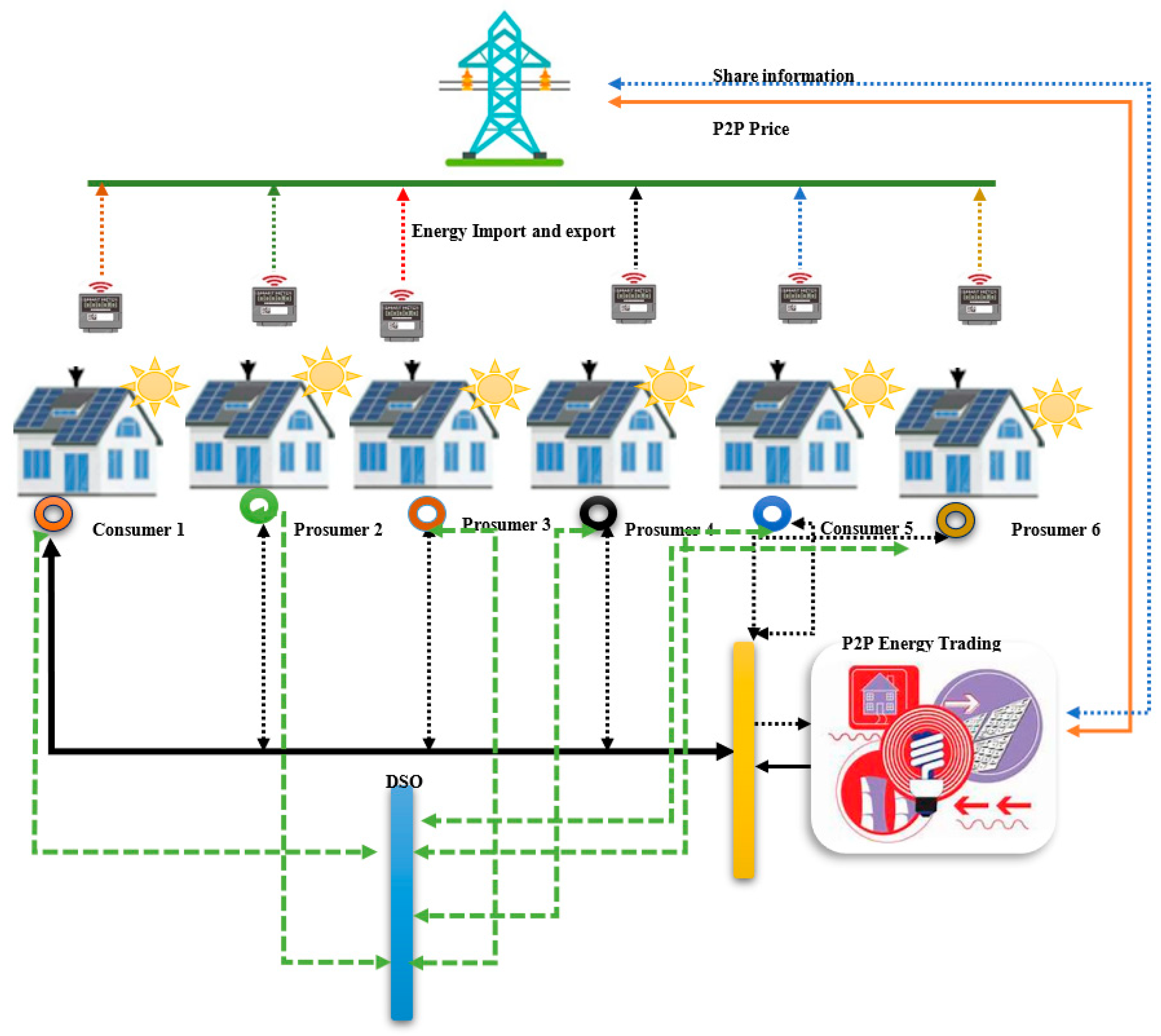
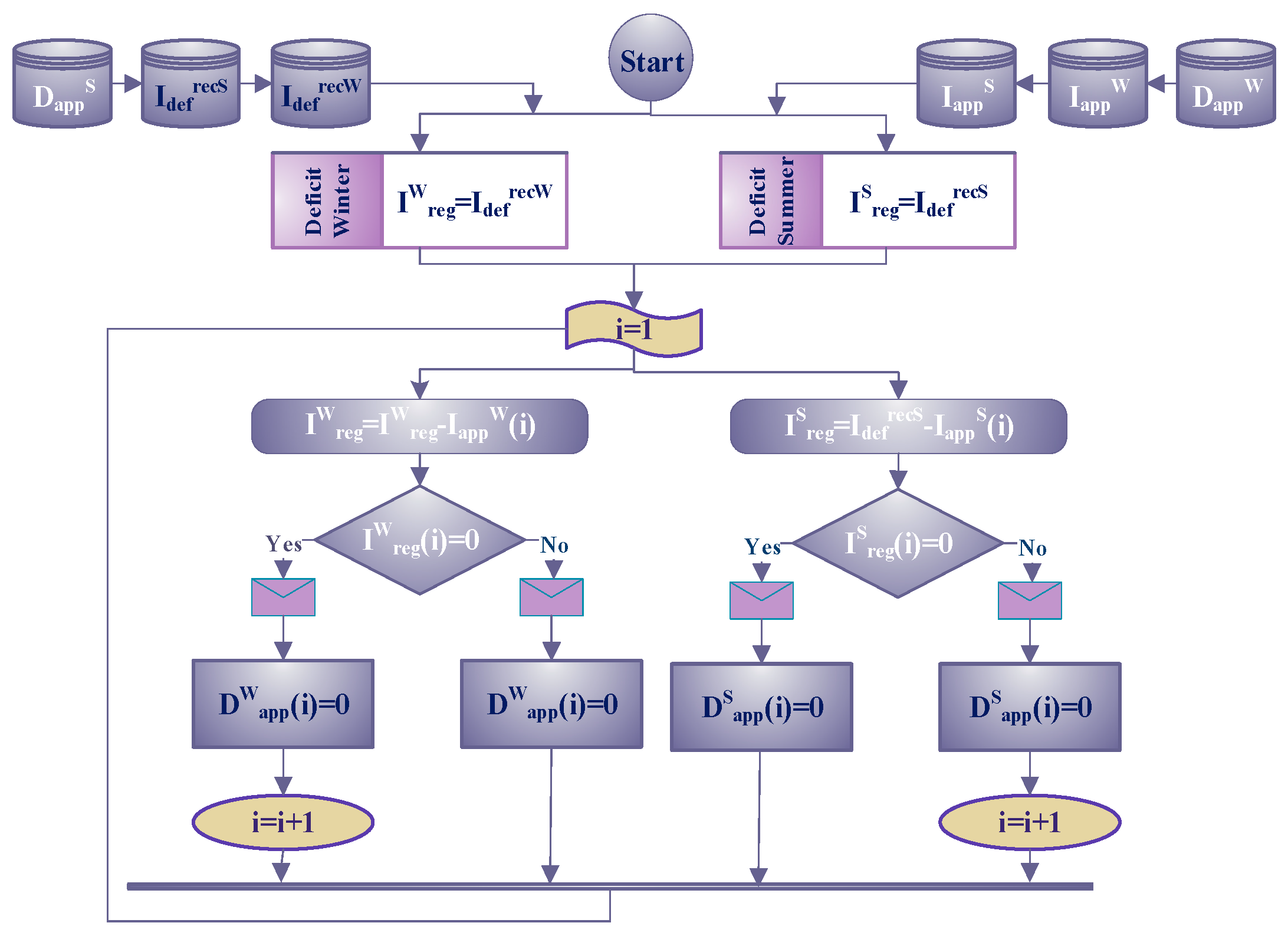
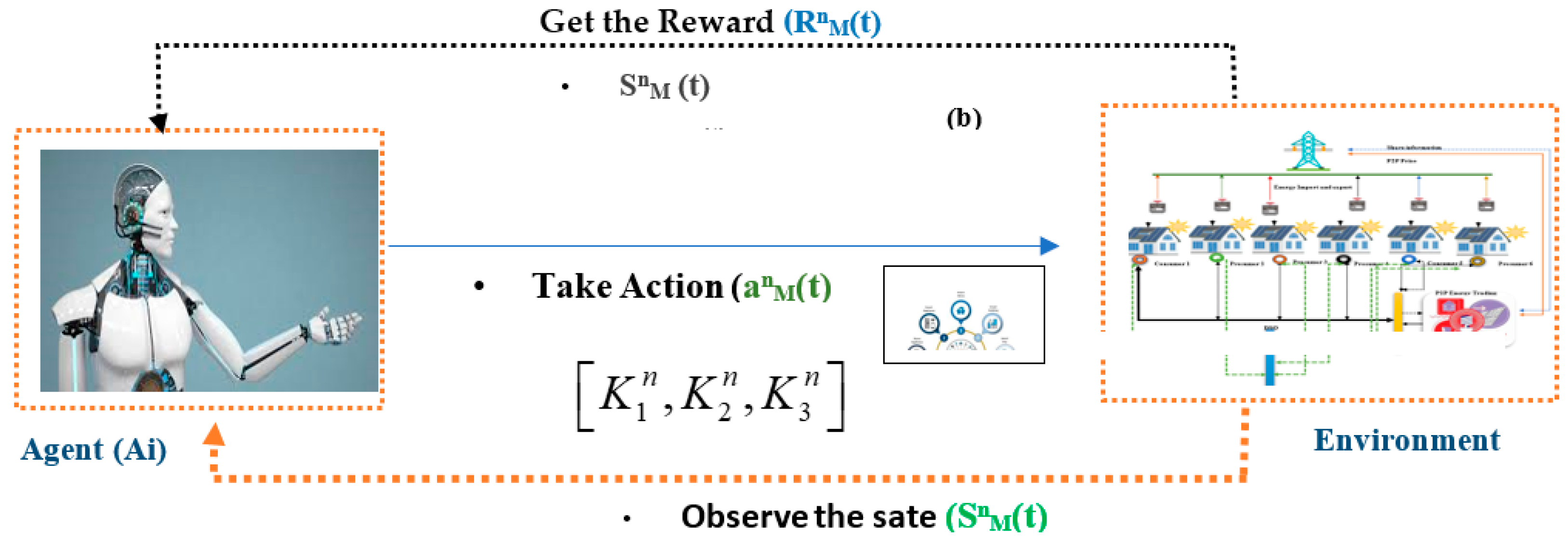
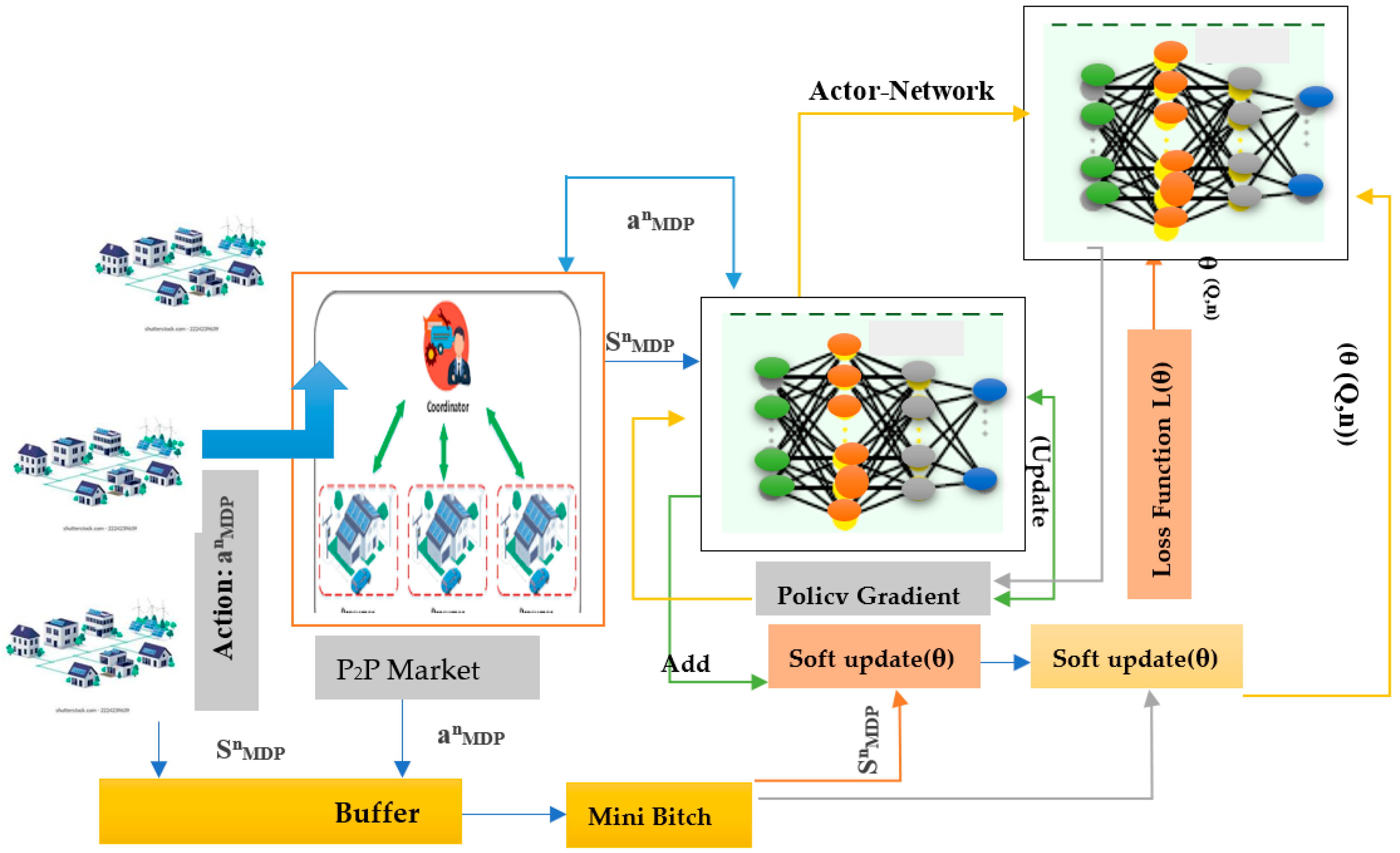
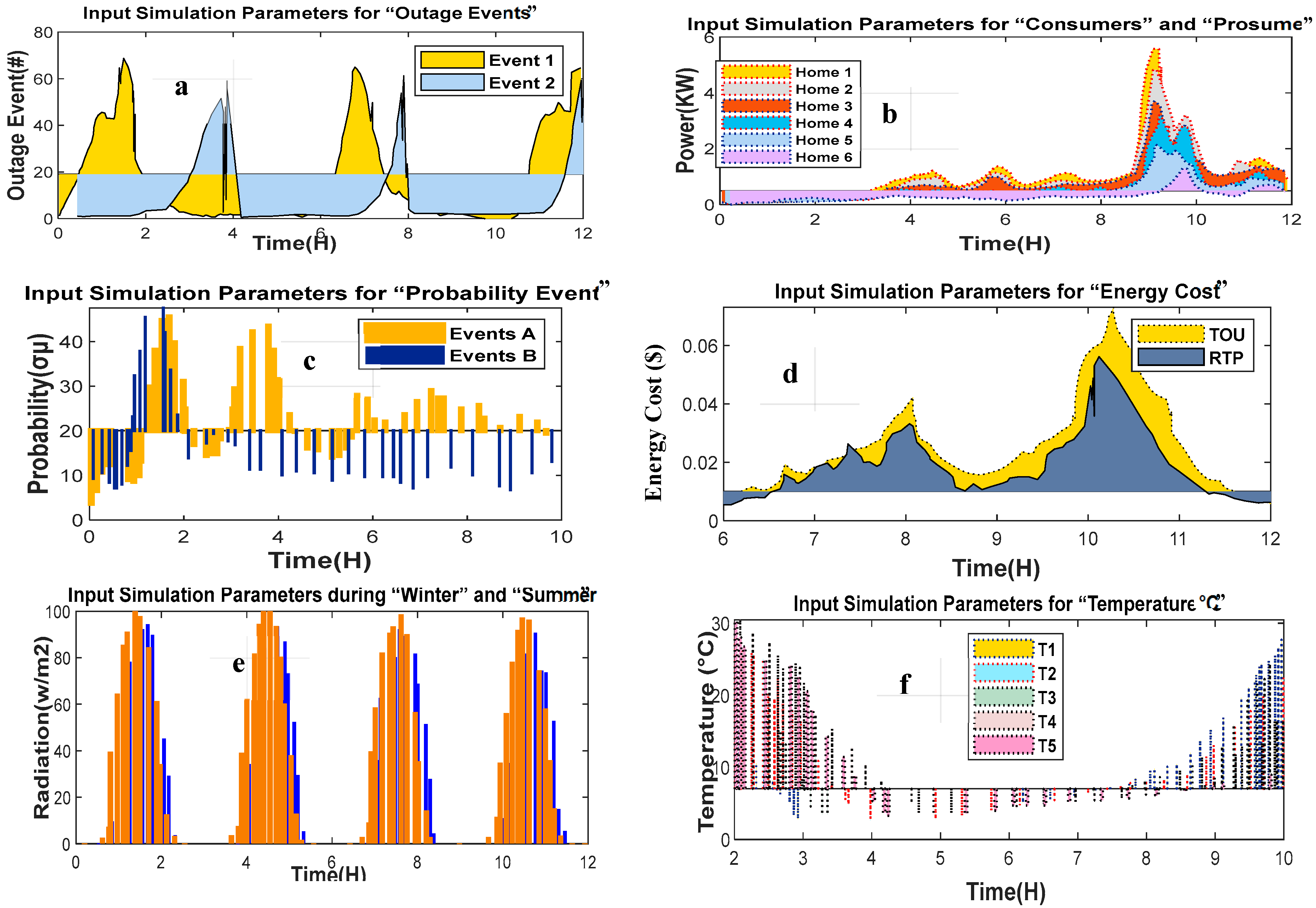

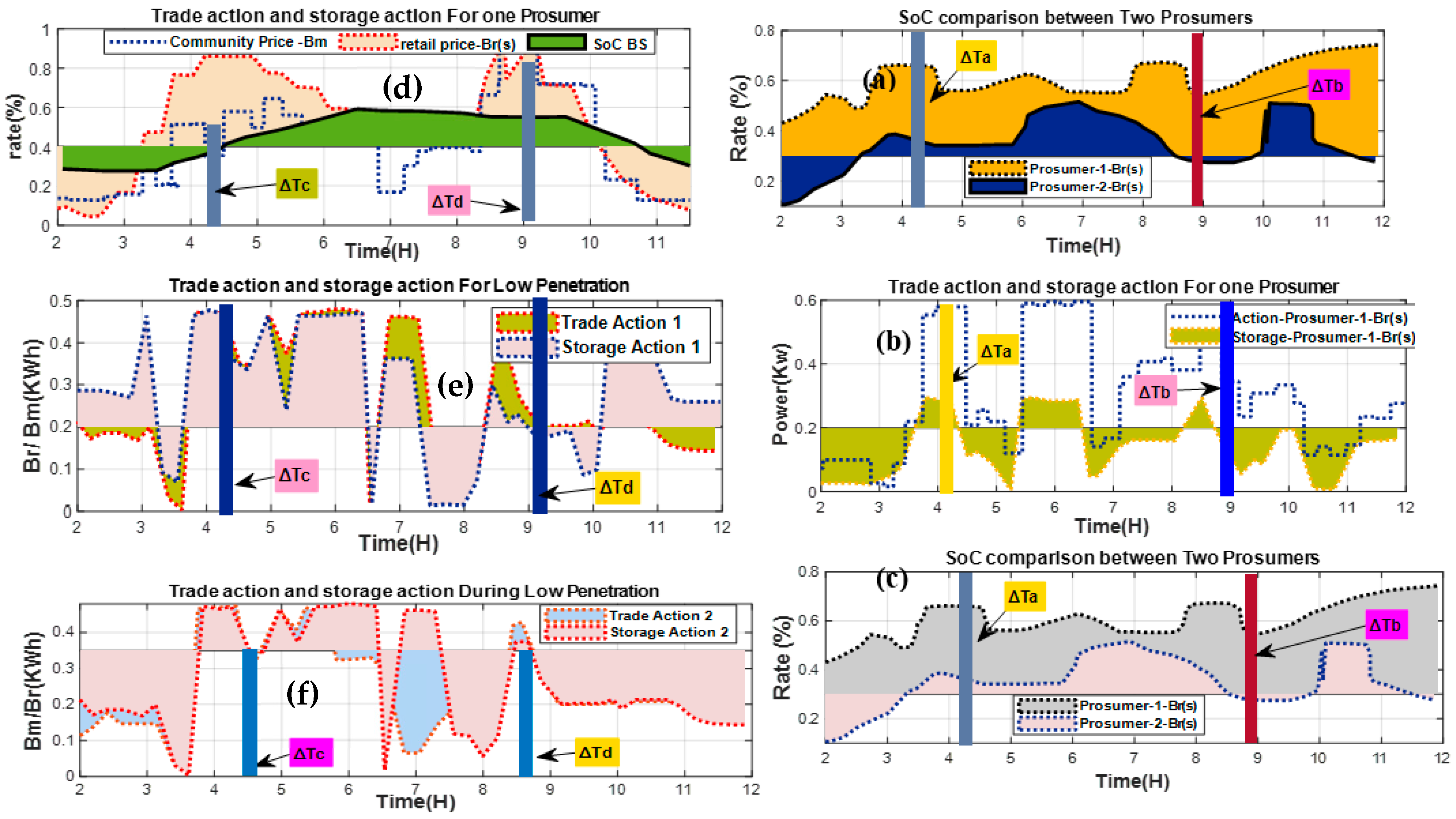
| P2P Market | Advantages | Limits | References |
|---|---|---|---|
| Decentralized market-(DeMark) | Interaction and conversation between individual customers directly. There is no obligation to exchange data with other parties, which enhances user privacy. Increased scalability, with customers able to join the P2P marketplace whenever they wish. | It will be more difficult to achieve the highest possible overall revenue. It may be difficult to keep track of decentralized users. | [40,42,43,44], [45,46,47,48,49,50,51,52,53]. |
| Centralized market-(Ce-Mark) | A centralized market revolves around the market coordinator, who directly determines the number of inputs and products and distributes the benefits among the many users, achieving the highest possible level of social well-being through the microgrid. Simple management. Complete democratization of the use of available energy sources. | Because of the sharing of food data, customer privacy may be compromised. Optimization aims to maximize overall benefits, which may mean ignoring specific user requirements to achieve this objective. | [19,20,21,22,23], [24]. |
| Distributed market-(DiMark) | In a distributed market, the market coordinator exercises indirect control over user energy exchanges and regulates user behavior through price signals. Distributed markets are halfway between centralized and decentralized markets. A system that can indirectly influence the behavior of users while preserving their privacy and individuality. | In determining market pricing signals, account must be taken of user behavior, actual market processes, and the need to minimize the negative consequences of market dispersion. | [25,26,27,28,29,30,31,32,33,34,35,36,37,38,39]. |
| Our Approach-(DeMark) | Customers/prosumers can enter the P2P market at any time, improving adaptability. | Discussions | ----------------- |
| Items | Parameters | Items | Parameters |
|---|---|---|---|
| System technical parameters | PV array Specification Costs | ||
| PV related Power | 1.0 kw | Whole Capital | 1130 $/kw |
| Interest rate | 4.80% | Total Maintenance per year | 5.001 $/kw |
| PV system lifetime | 25.0 | Replacement | 398.31 $/kwh |
| Rated Capacity: gratedSPV (kw) | 8.02 kw | Expected-lifetime per year | 21 |
| Investment cost (δPV) ($/kw) | 769.0 $/kw | BT array Specification Costs | |
| PV Cell Numbers | Ns 3; Np 6 | Whole Capital | 280 $/kw |
| PGrid,max (kw) | 9725 kw | Total Maintenance per year | 14.2 $/kw |
| Maximum G2H/H2G-(PHG, PHG) | 10 kw | Replacement | 305 $/kwh |
| PV Efficiency (ηPV) (pu) | 0.13% | Expected-lifetime per year | 11 |
| Max rated PV array power (kw) | 4.2 kw | Whole Capital | 1130 $/kw |
| BS Depth of discharge (DBS) (pu) | 0.6 | BS charge Efficiency (ηBS) (pu) | 0.97 |
| BS discharge Efficiency (ηBS) (pu) | 0.98 | ||
Disclaimer/Publisher’s Note: The statements, opinions and data contained in all publications are solely those of the individual author(s) and contributor(s) and not of MDPI and/or the editor(s). MDPI and/or the editor(s) disclaim responsibility for any injury to people or property resulting from any ideas, methods, instructions or products referred to in the content. |
© 2023 by the authors. Licensee MDPI, Basel, Switzerland. This article is an open access article distributed under the terms and conditions of the Creative Commons Attribution (CC BY) license (https://creativecommons.org/licenses/by/4.0/).
Share and Cite
Mahmoud, M.; Slama, S.B. Peer-to-Peer Energy Trading Case Study Using an AI-Powered Community Energy Management System. Appl. Sci. 2023, 13, 7838. https://doi.org/10.3390/app13137838
Mahmoud M, Slama SB. Peer-to-Peer Energy Trading Case Study Using an AI-Powered Community Energy Management System. Applied Sciences. 2023; 13(13):7838. https://doi.org/10.3390/app13137838
Chicago/Turabian StyleMahmoud, Marwan, and Sami Ben Slama. 2023. "Peer-to-Peer Energy Trading Case Study Using an AI-Powered Community Energy Management System" Applied Sciences 13, no. 13: 7838. https://doi.org/10.3390/app13137838
APA StyleMahmoud, M., & Slama, S. B. (2023). Peer-to-Peer Energy Trading Case Study Using an AI-Powered Community Energy Management System. Applied Sciences, 13(13), 7838. https://doi.org/10.3390/app13137838






